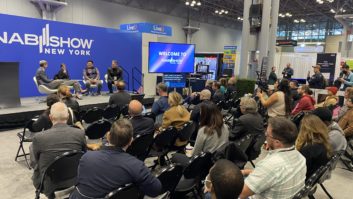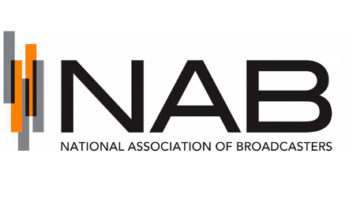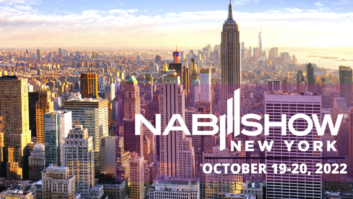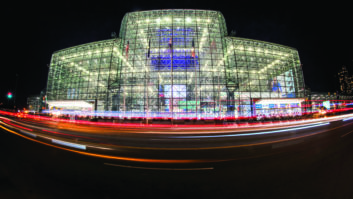New NAB President/CEO Curtis LeGeyt welcomed the broadcast industry back to the spring NAB Show after three years, with opening remarks on Monday here in Las Vegas.
His remarks suggest a continuation of the themes and priorities that the association has emphasized in the recent past under Gordon Smith: that Congress should pass legislation to rein in the market power of big tech platforms; that lawmakers and regulators must modernize media ownership laws to reflect realities of the marketplace; that “the FCC must recognize that the broadcast industry’s ability to function in the public interest is fundamentally premised on its economic viability”; and that NAB strongly opposes a new performance fee on local radio stations.
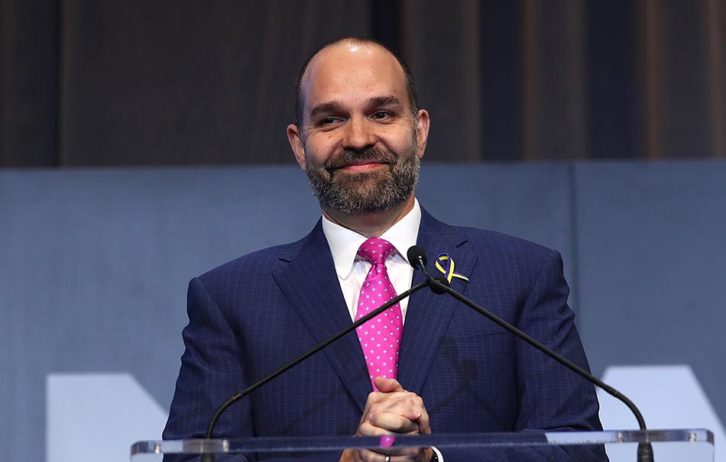
He expressed excitement at the evolution of radio. “Radio in the car is becoming a screen-driven experience. The data capabilities of HD Radio and the connected car give broadcasters powerful new ways to build and extend their listener relationships.”
Here are his remarks as prepared for delivery:
Welcome to the 2022 NAB Show! Six words that I’ve waited three years to say!
It is great to have all of you back in Las Vegas — reenergized as an industry and ready to seize the opportunities before us.
Whether this is your first NAB Show or just your first time back since we last met in 2019, this week will offer a reimagined and unforgettable experience as we explore the technologies that will power this industry for years to come.
As some of you know, this is my first NAB Show since I took on the role of NAB president and CEO in January.
As I have made my way around the Show floor, many of you have asked about my biggest thrill, challenge, or surprise since taking over my new role.
It’s a good question and one that brings to mind the reactions of my own young kids when they learned of my new job.
My daughter, Caitlin, wrote me a note. It congratulated me on my ‘new, but still “boring” job…’
My oldest son, Jack’s only question was how long it would take to institute a “free nachos” policy for our entire staff back in Washington.
And my youngest, Desmond’s only question was whether this would mean fewer meetings.
Nothing like kids to keep you humble, or to keep your priorities in check. But in truth, my first few months have been anything but boring.
There is truly no greater honor than representing your interests in the halls of government every day, and I cannot imagine a more exciting or more important time to take the reins of this great association.
Much has happened since the last time we were together at this NAB Show. As a result, the stakes for local broadcasters and the audiences who rely on us have never been greater.
We have confronted a deadly pandemic, civil unrest, and attacks on democracy at home and abroad. Our social and professional lives were upended and forever changed.
But in spite of these challenges, one thing was a constant, comforting presence — local broadcasters.
Through everything, you were — and are — a leading voice in helping communities sort through a multitude of information and emotions, while also striving to find common ground and common good.
Amid your own harsh business challenges of the past two years, you — local broadcasters — have done your best work, serving as a constant lifeline during times of emergency, informing our audiences with fact-based reporting, and providing the best entertainment.
And here’s the part that impresses me most: you did it in a way that binds our communities together rather than divides them. In the most difficult of circumstances, you were the antidote to social media disinformation and cable news politicization, and I have never been more proud to represent this industry.
Walking around our Show floor this morning, I marveled at the ways that new technologies will enhance our ability to deliver on this mission.
For years, our critics have tried to write us off as yesterday’s technology, predicting a diminished future for broadcasters at the hands of the latest innovation.
First it was the advent of television itself, then competition with cable, the VCR, the DVR, social media, and now podcasts and streaming, broadcasters’ demise has been predicted for decades.
But here’s the thing. Every single time, real-life events actually brought local broadcasters back to the forefront and demonstrated there is no other medium that can connect and inform the way we do.
Our next generation of technologies includes not only the revolutionary new broadcast standard — ATSC 3.0 — but also other content delivery methods — whether it’s 5G, streaming, or mobile video.
I am also excited by the evolution of radio. Radio in the car is becoming a screen driven experience. The data capabilities of HD Radio and the connected car give broadcasters powerful new ways to build and extend their listener relationships.
Our investment in technology is an investment in localism and the trusted journalism Americans rely on every day.
And as we are making that investment, I am here to tell you that NAB is working with policymakers in our nation’s capital to ensure they do their part to protect broadcasters’ ability to innovate and grow our uniquely free service.
To that end, I want to briefly outline four areas where policymakers must focus to ensure that broadcasters can continue to compete and thrive in today’s environment.
First, Congress must take action to rein in the gatekeeping ability of the Big Tech giants who are stifling the economics of local news.
A 2021 study found that local broadcasters lose an estimated $2 billion annually when our content is accessed through Google and Facebook. $2 billion! But this is not a copyright problem, it’s a market power problem.
Broadcasters and all local media rely on these platforms to reach online audiences. We have no other choice. Yet their market dominance allows them to offer us “take it or leave it” compensation terms that significantly devalue our product.
During his recent testimony before the Senate Antitrust Subcommittee, Joel Oxley, general manager of WTOP in Washington, summarized Big Tech’s unfair advantage.
He said: “Consider the big storm that just blew through the Northeast…blizzard conditions. Tons of work at a lot of cost and time for local broadcasters. But not for Facebook, Google and the like. They simply take our coverage, profit from it, and virtually nothing comes back to us. If we don’t find a way to have true partnerships with the big platforms, we will not be around — and neither will our coverage.” And Joel is right.
Without broadcasters, lives would have been risked during that storm. And that is not all.
A recent study by Brookings shows that Americans are harmed when local news suffers. Inadequate local news has been linked to more government corruption, less-competitive elections, and weaker municipal finances.
That is why Congress must pass legislation to rein in the market power of the big tech platforms. That includes the Journalism Competition and Preservation Act, which would level the playing field for broadcasters. This bill would allow us to jointly negotiate the value of our local content that is accessed through these platforms.
There is no long-term business model for local news if we don’t fix this existential problem.
This brings me to my second point. Lawmakers and regulators must modernize media ownership laws to reflect the realities of the marketplace.
A report released last Congress by Senate Commerce Chair Maria Cantwell noted that Google and Facebook control an estimated 77 percent of locally focused digital advertising.
Yet broadcasters still operate under a set of rules that pretend they only compete with one another.
We are adapting our business models and our content to match today’s rapidly changing media landscape. But outdated laws force us to compete with one arm tied behind our back for advertising dollars and audience.
Congress and the FCC must take a fresh look at whether these decades-old regulations are helping or impeding broadcast competition and media diversity.
Third, as I look forward to discussing with Chairwoman Rosenworcel in a few minutes, we are urging the FCC to reorient how it thinks about broadcast policy more broadly.
One hundred years ago, Congress established a system in which broadcast stations were licensed to provide a free service to local communities in the public interest. Broadcasters take these public interest obligations seriously and go far above and beyond in serving their listeners and viewers every day.
But to fulfill Congress’s vision, it is imperative that the FCC recognize that the broadcast industry’s ability to function in the public interest is fundamentally premised on its economic viability.
This means the Commission must consider whether each existing and new regulation will help or impede broadcasters’ ability to thrive in a media environment dominated by other services.
It means embracing the tremendous consumer benefits of ATSC 3.0 and adopting policies that enable its growth to the benefit of localism and trusted journalism.
And it also means the FCC working hand-in-hand with broadcasters to help us attract leading talent from all backgrounds to ensure our stations better reflect the diversity of the communities we serve.
But if we remain bogged down in all that could wrong instead of all that could go right, we will not succeed!
The fourth and final focus of our advocacy, we urge congressional support for the Local Radio Freedom Act, which opposes a new performance fee on local radio stations.
NAB welcomes a holistic discussion on music licensing reforms. We can grow the pie for creators while ensuring an economically viable broadcast industry. But a one-sided standalone performance fee on local radio stations will undermine our service.
In closing, broadcasting is more than a technology. It is a public service — interwoven in the fabric of our communities.
You may have recently seen a story about one of our own local D.C. meteorologists, Doug Kammerer, that just went viral. Doug was in the middle of a live broadcast when he saw on the radar a tornado moving in the direction of his home. He decided, while live on air, to call his children to warn them.
Afterwards, he recounted, “This was a scary moment for me. As I am zooming in on the radar, I noticed my house is right in the path of the tornado. My kids were home alone and I knew they would not be paying attention to the warning. As I was live on air, I was debating in my head if I should call them while I was on TV, and I soon realized I had to make the call. I had to protect my kids.”
As a father, I can’t imagine how worried Doug must have been for his family, and yet he felt a responsibility to also stay on the air to bring viewers the emergency weather report they needed to stay safe.
Doug is one of thousands of local broadcasters providing these kinds of lifelines in their communities every day. For Doug, the emergency was not an abstract one — he lives in the community he was reporting on. This is why our listeners and viewers know they can turn to us.
We broadcasters know that our duty to inform and find answers may put us in harm’s way. But we go about our work, day in and day out, because it is critical and needed now more than ever.
Because during times of emergency when our communities seek information to keep them safe and informed, we are there.
When our audiences feel overwhelmed and seek a reassuring voice, we are there.
And during uncertain times, when our listeners and viewers seek a human connection and comfort.
We are there to give hope.
My hope as your president and CEO is for us to continue our work together to always be there for our communities and give Americans the trusted local journalism only broadcasters can provide.





